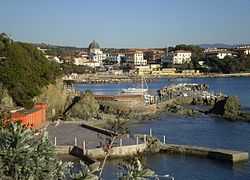Castiglioncello
| Castiglioncello | |
|---|---|
| Frazione | |
 | |
 Castiglioncello | |
| Coordinates: 43°24′19.39″N 10°24′37.07″E / 43.4053861°N 10.4102972°ECoordinates: 43°24′19.39″N 10°24′37.07″E / 43.4053861°N 10.4102972°E | |
| Country |
|
| Region | Tuscany |
| Province | Livorno (LI) |
| Comune | Rosignano Marittimo |
| Elevation | 23 m (75 ft) |
| Population | |
| • Total | 3,901 |
| Demonym | Castiglioncellesi |
| Time zone | CET (UTC+1) |
| • Summer (DST) | CEST (UTC+2) |
| Postal code | 57016 |
| Dialing code | 0586 |
| Patron saint | Andrew the Apostle |
| Website | Comune of Rosignano Marittimo Official website |
Castiglioncello is a frazione of the comune of Rosignano Marittimo, in the province of Livorno, Tuscany, Italy. It stands on a promontory reaching out into the Ligurian Sea, surrounded by pinewoods and hills that fall right down to the sea forming cliffs, little inlets, coves and sandy beaches.
The area was inhabited in Etruscan and Roman times, as attested by the presence of an ancient necropolis. The Medici Grand Dukes of Tuscany had a watch tower built here in the 17th century.
Castiglioncello has been a renowned sea resort since the 19th century. People who made their homes here include Luigi Pirandello, Marcello Mastroianni, Luchino Visconti and Vittorio Gassman.
The Macchiaioli, a group of Italian artists active in Tuscany in the second half of the nineteenth century who had some points in common with the French Impressionists, chose Castiglioncello as an inspirational focus for their work. Macchiaioli painters who dedicated time to Castiglioncello included Giovanni Fattori, Silvestro Lega and Telemaco Signorini, among others.
Places of interest
- Castello Pasquini: the castle was built between 1889 and 1891 in a style similar to that used for the Florentine palaces of the Middle Ages.
- Chiesa dell'Immacolata Concezione: the construction of the church was begun in 1922. The dome dates from the years immediately following the World War II, when the building was restored following wartime damage.
- Oratorio di Sant'Andrea Apostolo (Chiesa di Sant'Andrea): The church stands on the ruins of a 17th century oratory. The present structure dates from 1864.
- Torre di Castiglioncello: The tower dates back to 17th century and was part of the system of sight of the coast of Livorno. It underwent some changes in the 1800.
- National Archaeological Museum: set up at the beginning of the 20th century, it was closed around 1972-1973 but was reopened in 2001.[1]
- Monte Pelato (Poggio Pelato): the highest hill in the town has many paths for hiking, and provides views of the Mediterranean, as well as the remains of mines for magnesite.
Photo gallery
-

Bay of Quercetano
-
Sunset
-

Pasquini Castle
-

View from the Pasquini Castle looking towards the isle of Elba
-

Winter view of the bay of Quercetano
-
View of the tower
External links
- Castiglioncello Forum, tourist information
- General Site about Castiglioncello
- Webcam and meteo of Castiglioncello from Marina Cala de Medici port
References
All demographics and other statistics: Italian statistical institute Istat.

